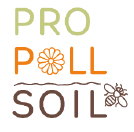Ongoing projects
 EU Horizon project Butterfly: Mainstreaming pollinator stewardship in view of cascading ecological, societal and economic impacts of pollinator decline
EU Horizon project Butterfly: Mainstreaming pollinator stewardship in view of cascading ecological, societal and economic impacts of pollinator decline
BUTTERFLY aims to take a transdisciplinary approach to assess the dependencies of our economy, society, and culture on pollinators and pollinator-dependent biodiversity. It will enhance society’s capacity to appraise, foresee, and respond to the threats posed by cascading impacts of pollinator decline. The project is a consortium of 24 institutions and is led by Jeroen Van der Sluijs (University of Bergen).
As part of this project, we will be creating a new atlas of pollination information (EuroAPPA) and expanding the DoPI dataset to include EU-wide records. There will be special emphasis on neglected pollinator groups. This is a collaboration with Nick Balfour, Jeff Ollerton, Jorrit Poelen (from GloBi) and many more consortium members.
 "Fire-smart" restoration for resilient livelihoods in Tropical Dry Forest
"Fire-smart" restoration for resilient livelihoods in Tropical Dry Forest
This is a collaborative project with the Universidad Distrital in Colombia (team led by Prof Angela Parrado-Rosselli) and Kew´s Millenium Seed Bank, funded by Sussex International Development Challenge Fund.
Wildfires are increasing in frequency and intensity globally, threatening vulnerable ecosystems and the people who depend on them. Tropical dry forests provide crucial ecosystem services but face growing fire risks from a drier climate and unsustainable farming. We aim to develop restoration strategies for the interface between farms and forests to create resilient “fire-smart” landscapes that reduce the risk of catastrophic fires. Fire-smart landscapes reduce poverty and safeguard biodiversity for the wellbeing of all.
Photo: Ceiba pentandra tree as part cattle farming landscape with tropical dry forest restricted to hills in the background (Magdalena Valley, Colombia)
 New EU Horizon project! ProPollSoil: Understanding and managing soil health impacts to protect soil-dependent pollinators
New EU Horizon project! ProPollSoil: Understanding and managing soil health impacts to protect soil-dependent pollinators
ProPollSoil will investgate the interactions between soil health and soil-dependent pollinators. The project aims to show how soil management practices and contamination threaten soil-dependent pollinators and contribute to their decline. ProPollSoil will ultimately use this knowledge to recommend pollinator-safe soil management practices and inform conservation and restoration activities targeting both soil health and pollinator habitat. The project is a consortium of 24 institutions and is led by Sara Leonhardt (Technical University of Munich).
As part of this project starting in late 2025, we will be expand the atlas of pollination information (EuroAPPA) we will create in BUTTERFLY.
 Plant resilience and floral adaptation to pollinator change
Plant resilience and floral adaptation to pollinator change
We use a combination of field studies and quantitative genetics to investigate the resilience and potential for evolutionary change of plant populations when faced with changes in pollinators (or lack thereof).
Recent publications:
Romero-Bravo, A. & M.C. Castellanos. 2024. Nectar and floral morphology differ in evolutionary potential in novel pollination environments. New Phytologist 243: 753-764.
Castellanos, M.C., J. Montero-Pau, P. Ziarsolo, J.M. Blanca, J. Cañizares & J.G. Pausas. 2023. Quantitative genetic analysis of floral traits shows current limits but potential evolution in the wild. Proceedings of the Royal Society B 290: 20230141.
Mackin, C.R., J.F. Peña, M.A. Blanco, N.J. Balfour & M.C. Castellanos. 2021. Rapid evolution of a floral trait following acquisition of novel pollinators. Journal of Ecology 109: 2234– 224
Mackin, C.R., D. Goulson & M.C. Castellanos. 2021. Novel nectar robbing negatively affects reproduction in Digitalis purpurea. Ecology and Evolution 11: 13455-13463.
Photo: Naturalised Digitalis purpurea in South America
 Effects of wildfires on plant-insect interactions
Effects of wildfires on plant-insect interactions
(with PhD students Yedra García and Julia Gegunde, co-supervised with Juli Pausas)
Yedra focused on the effects of time since fire and of fire size on antagonistic (herbivory and seed predation) and mutualistic (pollination) interactions. Ultimately, we are interested in the fitness consequences for plants involved in these interactions. You can read a summary of our work in this topic here.
Julia is also investigating the adaptive nature of post-fire blooming.
Recent publications:
García, Y., Castellanos, M.C. & Pausas, J.G. 2018. Differential pollinator response underlies plant reproductive resilience after fires. Annals of Botany 122: 961-971.
García, Y., M.C. Castellanos & J.G. Pausas. 2016. Fires can benefit plants by disrupting antagonistic interactions. Oecologia, 182:1165–1173.
Photo: Asphodelus ramosus blooming after a wildfire
 Evolutionary potential of floral and fire-related plant traits (with Juli Pausas)
Evolutionary potential of floral and fire-related plant traits (with Juli Pausas)
Plant traits such as flammability appear to vary adaptively in response to variable fire regimes. To confirm the adaptive nature of the variation of fire-related traits, we are measuring their heritability directly in wild populations of the shrub Ulex parviflorus. We use Genotyping-by-Sequencing to effectively measure relatedness of individuals in the field, based on thousands of molecular markers. As a control, we also measure heritability and response to selection in fire-independent plant traits (i.e. floral traits) in populations that have been historically exposed to different fire regimes. For our study using this approach with cone serotiny in pines (Pinus halepensis and P. pinaster), see here.
Photo: Floral buds of the Mediterranean Gorse, Ulex parviflorus


